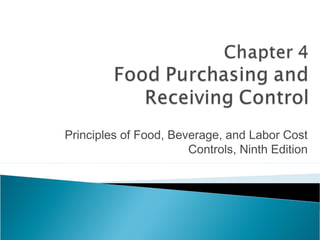Ch04
- 1. Principles of Food, Beverage, and Labor Cost Controls, Ninth Edition
- 2. ÔÅΩ Who does the purchasing? ‚ó¶ Owners ‚ó¶ Managers ‚ó¶ Chef ‚ó¶ Steward ÔÅΩ One person responsible so they can be held accountable
- 3. ÔÅΩ Perishables; those items that are typically fresh foods, and have a relatively short shelf life ÔÅΩ Non-perishables; those food items that have a relatively longer shelf life ‚ó¶ Groceries ‚ó¶ Staples ‚ó¶ Storeroom items
- 4. 1. Quality of food purchased 2. Quantity of food purchased 3. Prices at which food is purchased
- 5. 1. They force owners or managers to determine exact requirements in advance 2. They are often useful in menu preparation 3. They eliminate misunderstandings between stewards and purveyors 4. Allows for true competitive bidding 5. Eliminates need for detailed verbal descriptions 6. They facilitate checking food as it is received
- 6.  Steward’s market quotation list - a form often used as a tool by food purchasers for; ◦ Taking daily inventory of perishables ◦ Determining suitable order quantities ◦ Recording market quotations ◦ Selecting vendors  Par stock – maximum quantity that should be on hand at any given time
- 7. ÔÅΩ Periodic order method: Amount required for the upcoming period - Amount presently on hand + Amount wanted on hand at the end of the period to last until the next delivery = Amount to order
- 8. ÔÅΩ Perpetual inventory method: Par stock - Reorder point = Subtotal + Normal usage until delivery = Reorder quantity
- 9. 1. Storage space 2. Limits on total value of inventory prescribed by management 3. Desired frequency of ordering 4. Usage 5. Purveyors’ minimum order requirements
- 10. 1. Wholesalers 2. Local Producers 3. Manufacturers 4. Packers 5. Local farmers 6. Retailers 7. Cooperative associations
- 11. Advantages: ÔÅΩ Foods and beverages can be purchased at lower prices because of volume ÔÅΩ Desired quality can be obtained more readily because the steward has a greater choice of markets ÔÅΩ Foods can be obtained that meet specs ÔÅΩ Larger inventories can be maintained, ensuring reliable supply to individual units ÔÅΩ Possibility of dishonest purchasing in individual units are greatly reduced
- 12. Disadvantages:  Each unit must accept the standard item in stock and has little freedom to purchase for its own particular needs  Units can’t take advantage of local specials  Menus are ordinarily standardized, limiting the individual unit managers’ freedom
- 13. 1. Telephone 2. Fax 3. Quotation sheets obtained by mail 4. Fax modem 5. Information supplied by salespersons 6. Direct computer links with purveyors via the internet or dedicated telephone line
- 14. 1. The quantity delivered should be the same as the quantity listed on the Steward’s Market Quotation List and the invoice 2. The quality delivered should conform to the establishment’s specifications 3. The prices on the invoice should match those circled on the Steward’s Market Quotation List
- 15. Meats R’ Us 777 Cow Pasture Way Bulls tail, IO To: Grandview Bistro Date: October 3, 20XX Quantity Unit Description Unit Price Amount 20 lbs. Beef tenderloin 9.20 184.00 20 lbs. Leg of lamb 12.40 248.00 $432.00
- 16. ÔÅΩ Regardless of the methods used by employees to requisition food and beverage products, or management to issue these, inventory levels will be affected. ÔÅΩ It will be your responsibility and that of your purchasing agent to monitor this movement and purchase additional products, as needed. ÔÅΩ Re-stocking the inventory is critical if product shortages are to be avoided and if product necessary for menu item preparation is to be available.
- 17. ÔÇß Operators must be careful not to overload storage capacity. Increased inventory of items generally leads to greater spoilage and loss due to theft. ÔÇß Shelf life is the amount of time a food item retains its maximum freshness, flavor, and quality while in storage. The shelf life of food products varies greatly. ÔÇß The cost to the vendor for frequent deliveries will be reflected in the cost of the goods to the operator.
- 18. 1. Storage capacity 2. Item perishability 3. Vendor delivery schedule 4. Potential savings from increased purchase size 5. Operating calendar 6. Relative importance of stock outages 7. Value of inventory dollars to the operator
- 19. 1. Verify the quantity, quality, and price for each item conforms exactly to the order placed 2. Verify invoice with rubber invoice stamp 3. List foods delivered each day on the receiving Clerk’s Daily Report for that day 4. Forward paperwork to proper personnel 5. Move food to appropriate storage areas
- 20. 1. Verification of the date food received 2. Signature of the receiving clerk who vouches for the accuracy of the order 3. Steward’s signature, acknowledging delivery of food items 4. Food controller’s verification calculations are correct on the invoice 5. Signatory approval of the bill for payment by an authorized individual before a check is drawn
- 21.  Directs – foods that extremely perishable by nature, purchased daily. ◦ For immediate use ◦ Considered to be issued on delivery ◦ Go directly onto today’s food cost  Stores – perishable but have a relatively longer shelf life. ◦ Not for immediate use ◦ Included on food cost when they are issued
- 22.  The great problem in employing receiving personnel is with the vast amount of knowledge of foods these workers require  This may explain why some restaurants do not require quality checks upon delivery  Someone has to do it!!!  If not your customers will!!! © John Wiley & Sons, Inc. 2009






















